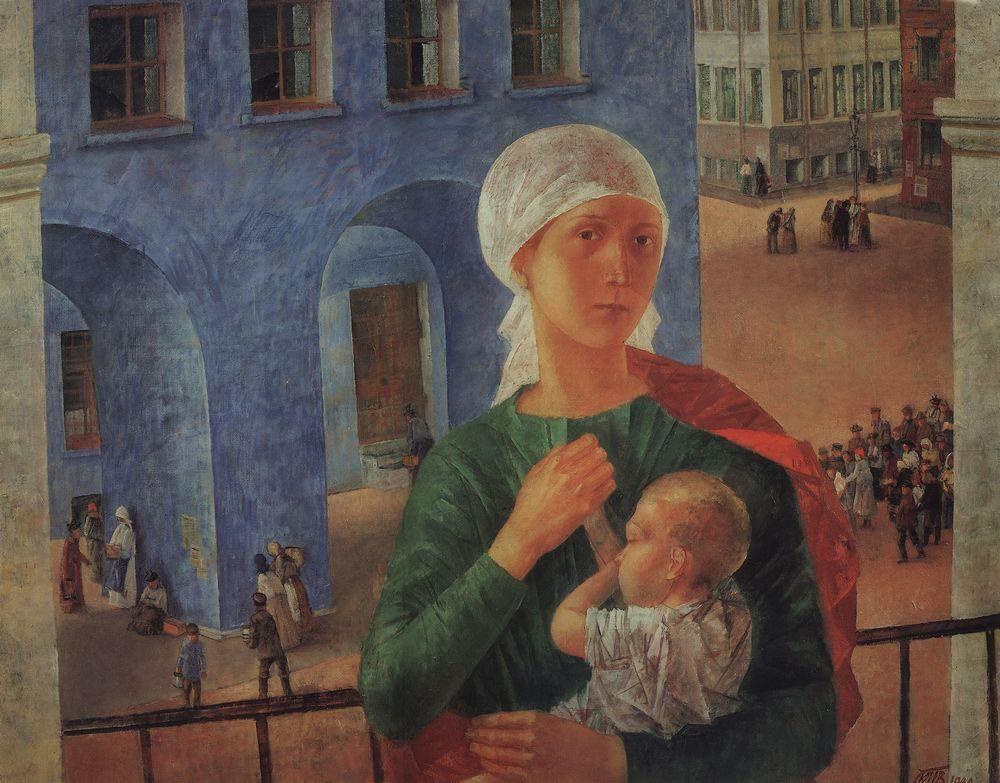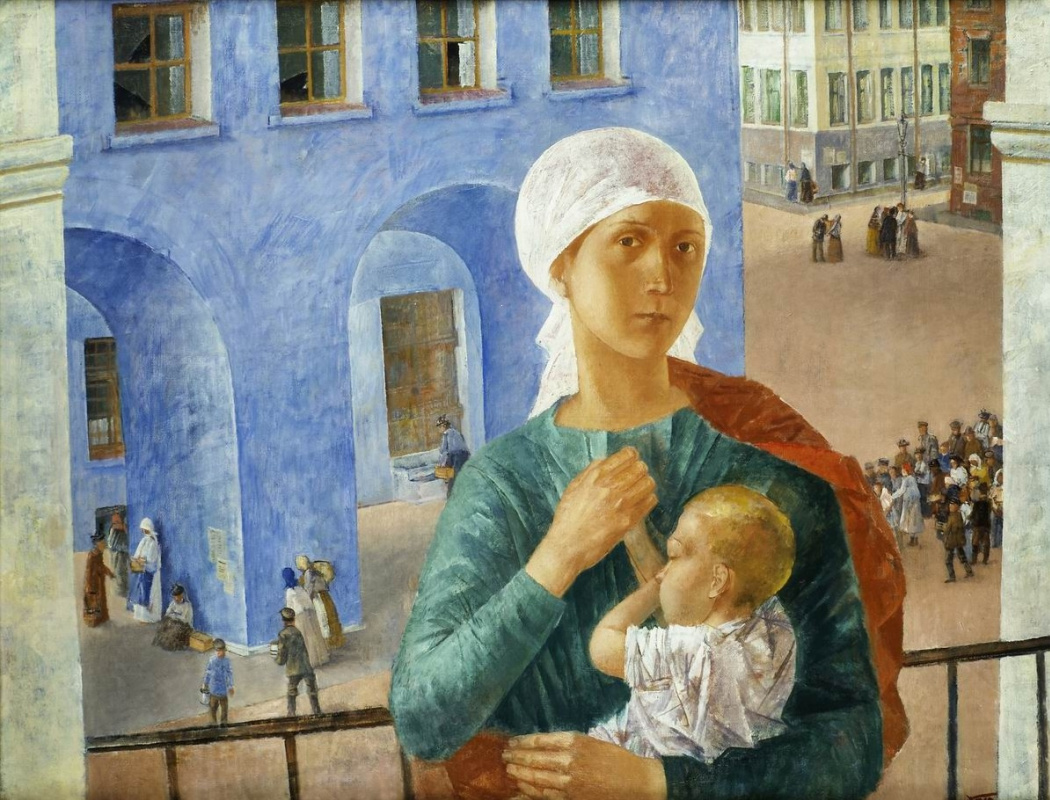log in
Enter site
Login to use Arthive functionality to the maximum
1918 in Petrograd (The Petrograd Madonna)
Kuzma Sergeevich Petrov-Vodkin • Peinture, 1920, 73×92 cm
Descriptif de la toile «1918 in Petrograd (The Petrograd Madonna)»
In 1918, Kuzma Petrov-Vodkin became one of the founders and active participants of Volfila (Free Philosophical Association). It was a territory of free opinion, new ideas of directors, poets, artists, a magnet for young and hungry students. Andrei Bely read Symphonies and the Crisis of Culture report here, Alexander Blok read his Twelve poem even before it was published, and Yevgeny Zamyatin read the We novel as a warning about the “danger of state absolutism”. The participants did not speak about politics and believed that the political revolution should become the basis for the spiritual revolution first of all. The main topics in Volfila clubs, circles and discussions were the philosophy of art and the spiritual transformation of man. All that was still possible even in the early 1920s. Despite hunger, bread queues, poverty, cold houses and discussion halls, many saw the beginning of rebirth and renewal in the crumbling dilapidated world order.
In his Euclid’s Space book, Petrov-Vodkin wrote: “The resettlement of peoples sideways is over; there is nowhere else to go... it means that only the up direction remains for the spatial well-being of peoples: who will reach his creative energy higher... The match is to be universal...”
At that time, the artist was working on his painting “Petrograd. 1918”, however the picture immediately got a different name. As is often the case, the new name turns out to be so accurate that they pick it up and consider it real — now everyone calls the painting “The Petrograd Madonna”. A Christian symbol of hope, salvation, renewal in the city that was renamed by the revolution.
Spiritual height, the victory over the force of gravity, which the artist dreams of, is embodied literally and visibly in the mother’s position high above the city. The balcony railing reconciles this ascension with reality, but this does not explain the size difference. The small figures of the people who are crowding in the city square resemble, rather, miniature hagiographic scenes in the icon fields than the real background of the picture. The balcony here is the same way to get off the ground, like the endless hills in Petrov-Vodkin’s paintings (1, 2, 3), as well as the position of the rider who soared up over the water in"Bathing of the red horse" or over land - in "Fancy".
The Petrograd Madonna is beautiful with a calm mystical beauty, iconic or Renaissance, Old Ruthenian or Italian beauty. The red cloak on her shoulder forms the sculpted folds. The baby in her arms is a dormant hope, a new life that has to grow, jump on its horse, rush over the land and sea, reach the sky in one easy jump, overcome the notorious power of the earth’s gravity with its power of creativity and thought. He will definitely wake up full of energy, he will start walking in 1919, say the first difficult words in 1920. He does not need to know yet what awaits him and his country in the future.
The Free Philosophical Association would close in 1924. By this time Andrei Bely would leave for Berlin, and Blok would die of cold, hunger, asthma, with a weakened and worn out heart, with a ban on treatment abroad. Zamyatin would be arrested and twice tried to be expelled from Russia. Persecution and emigration would await him. But the baby is still asleep and it dreams of the large planet around him and the new starting life.
Author: Anna Sidelnikova
In his Euclid’s Space book, Petrov-Vodkin wrote: “The resettlement of peoples sideways is over; there is nowhere else to go... it means that only the up direction remains for the spatial well-being of peoples: who will reach his creative energy higher... The match is to be universal...”
At that time, the artist was working on his painting “Petrograd. 1918”, however the picture immediately got a different name. As is often the case, the new name turns out to be so accurate that they pick it up and consider it real — now everyone calls the painting “The Petrograd Madonna”. A Christian symbol of hope, salvation, renewal in the city that was renamed by the revolution.
Spiritual height, the victory over the force of gravity, which the artist dreams of, is embodied literally and visibly in the mother’s position high above the city. The balcony railing reconciles this ascension with reality, but this does not explain the size difference. The small figures of the people who are crowding in the city square resemble, rather, miniature hagiographic scenes in the icon fields than the real background of the picture. The balcony here is the same way to get off the ground, like the endless hills in Petrov-Vodkin’s paintings (1, 2, 3), as well as the position of the rider who soared up over the water in"Bathing of the red horse" or over land - in "Fancy".
The Petrograd Madonna is beautiful with a calm mystical beauty, iconic or Renaissance, Old Ruthenian or Italian beauty. The red cloak on her shoulder forms the sculpted folds. The baby in her arms is a dormant hope, a new life that has to grow, jump on its horse, rush over the land and sea, reach the sky in one easy jump, overcome the notorious power of the earth’s gravity with its power of creativity and thought. He will definitely wake up full of energy, he will start walking in 1919, say the first difficult words in 1920. He does not need to know yet what awaits him and his country in the future.
The Free Philosophical Association would close in 1924. By this time Andrei Bely would leave for Berlin, and Blok would die of cold, hunger, asthma, with a weakened and worn out heart, with a ban on treatment abroad. Zamyatin would be arrested and twice tried to be expelled from Russia. Persecution and emigration would await him. But the baby is still asleep and it dreams of the large planet around him and the new starting life.
Author: Anna Sidelnikova



